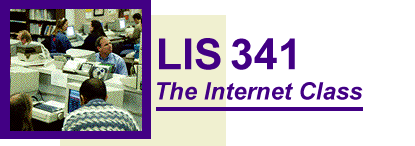
Introduction to Internet Resources and Services
Spring '99
#43405 (Tue)
#43400 (Thu)
Homework One
Instructions: This assignment is due at the start of class three. Please be sure to review
(and follow!) the requirements for homework
assignments.
Please be brief. For most questions, just a word or two will
suffice.
We'll discuss these exercises in class. Bring a copy of your
answers.
Exercise 1. In our introduction to the class, we discussed
the importance of backups.
- Question 1.1. Where will you primarily do your Internet
work for this class?
- Question 1.2. What is your "equipment backup" plan
in the event of computer failure or problems?
- Question 1.3. What is your plan for "data backups" so
that your important work is protected against equipment
malfunction or accidental deletion?
Exercise 2. In class and in Lehnert section 2.1, we were introduced
to several of the services available on the Internet. They include:
email, Usenet news, FTP, gopher and web. For each activity below,
select one service from that list that would be a suitable choice
for the indicated task.
- Question 2.1. Make an inquiry of a colleague.
- Question 2.2. Discuss a question among a group of
colleagues.
- Question 2.3. Publish a directory of names and telephone
numbers to a group of colleagues.
Exercise 3. For each of the following, indicate:
client, server, or neither.
- Question 3.1. Eudora - a mail reader for PC and Mac.
- Question 3.2. sendmail
- an SMTP mail transport.
- Question 3.3. ping
- Question 3.4. pine - a mail reader that runs under Unix.
- Question 3.5. pico - the editor typically used to compose
email messages under pine.
- Question 3.6. Windows '98
Exercise 4. For each of the following protocols, indicate
which layer it fulfills (application, transport,
network, or datalink) in the TCP/IP protocol stack.
- Question 4.1. The Interactive Mail Access Protocol (IMAP).
A protocol to access and manage a remote mailbox and mail folders.
- Question 4.2. The Serial Line Interface Protocol
(SLIP). A protocol invented by Phil Karn (KA9Q) to transmit
data across amateur packet radio.
- Question 4.3. Real
Video. A protocol for streaming audio/video.
- Question 4.4. The Reliable Datagram Protocol (RDP).
A connectionless protocol that reliably transmits "datagrams" of
information.
Exercise 5. Your boss wants to publish a web page on a
free web hosting service. The choice has been narrowed to either
Tripod or Crosswinds. Your task
is to analyze the network response of these two services and make
a recommendation. "Why, this is a job for ping!"
you exclaim.
- Question 5.1. What is the average round trip time you
measure to Tripod?
- Question 5.2. What is the average RTT to
Crosswinds?
- Question 5.3. Based on these results, which service
would you prefer to use?
- Question 5.4. If you repeat these tests on another
day, should you expect to see similar results?
- Question 5.5. If you repeat these tests from a
distant location -- say Toronto -- should you expect to see
similar results?
- Question 5.6. Which is better, a ping time
of 500 msec or 0.05 sec?
Roamwork Exercise. The following questions send you out
to the net to locate some information.
- Question R.1. How many stars did Roger Ebert, movie
critic for the Chicago Sun Times, give to You've
Got Mail?
[hint: http://crayon.net/using/links.html
]
- Question R.2. What is the speed of 10Base-T
Ethernet in megabits/sec (Mbps)? [hint: http://www.pcwebopaedia.com/
]
- Question R.3. How many calories are in a McDonalds'
Big Mac?
BACK:
Homework |
LIS 341 |
GSLIS |
UT
 Chip Rosenthal
Chip Rosenthal
<chipr@gslis.utexas.edu>
$Id: homework_01.html,v 4.4 1999/02/04 08:49:23 chip Exp $
